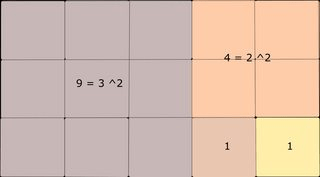题目
The drawing below gives an idea of how to cut a given “true” rectangle into squares (“true” rectangle meaning that the two dimensions are different).

Can you translate this drawing into an algorithm?
You will be given two dimensions
- a positive integer length (parameter named
lng) - a positive integer width (parameter named
wdth)
You will return an array with the size of each of the squares.
Shell bash returns a string.
Examples
1 | sqInRect(5, 3) should return [3, 2, 1, 1] |
#Note: lng == wdth as a starting case would be an entirely different problem and the drawing is planned to be interpreted with lng != wdth.
思路
题目的含义是将一个长方形切割成正方形,且正方形尽可能的大。看返回值的规律应该是,将两个数值相减,直至两个数值相等。需要使用递归。
但是初步写完测试后,返现不是这个规律。sqInRect(20, 14) should return [14, 6, 6, 2, 2, 2]这个就不适用。
答案
我的答案
1 | def sqInRect(lng, wdth): |
最佳答案
最佳实践解法
1
2
3
4
5
6
7
8
9
10
11
12
13def sqInRect(lng, wdth):
if lng == wdth:
return None
if lng < wdth:
wdth, lng = lng, wdth
res = []
while lng != wdth:
res.append(wdth)
lng = lng - wdth
if lng < wdth:
wdth, lng = lng, wdth
res.append(wdth)
return res递归的解法
1
2
3
4
5
6
7# Recursive solution
def sqInRect(lng, wdth, recur = 0):
if lng == wdth:
return (None, [lng])[recur] # If this is original function call, return None for equal sides (per kata requirement);
# if this is recursion call, we reached the smallest square, so get out of recursion.
lesser = min(lng, wdth)
return [lesser] + sqInRect(lesser, abs(lng - wdth), recur = 1)
本题的难点在于题目的理解,本人就在题目的理解上花费了较长的时间。
可以看出我的解法是和最佳实践解法类似的,看来一般递归解法不属于最佳实践,因为递归的代码相对较为难懂。


